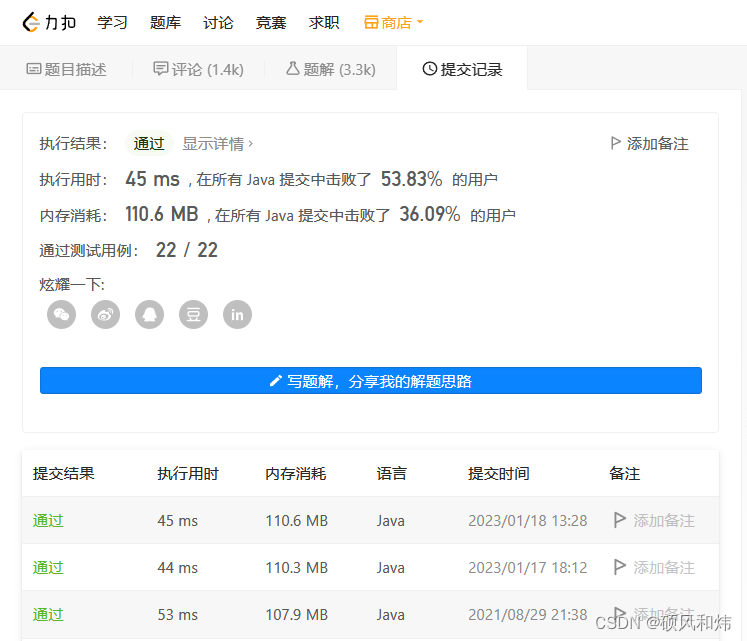题目描述
请你设计并实现一个满足 LRU (最近最少使用) 缓存 约束的数据结构。
实现 LRUCache 类:
LRUCache(int capacity) 以 正整数 作为容量 capacity 初始化 LRU 缓存
int get(int key) 如果关键字 key 存在于缓存中,则返回关键字的值,否则返回 -1 。
void put(int key, int value) 如果关键字 key 已经存在,则变更其数据值 value ;如果不存在,则向缓存中插入该组 key-value 。如果插入操作导致关键字数量超过 capacity ,则应该 逐出 最久未使用的关键字。
函数 get 和 put 必须以 O(1) 的平均时间复杂度运行。
示例:
输入
[“LRUCache”, “put”, “put”, “get”, “put”, “get”, “put”, “get”, “get”, “get”]
[[2], [1, 1], [2, 2], [1], [3, 3], [2], [4, 4], [1], [3], [4]]
输出
[null, null, null, 1, null, -1, null, -1, 3, 4]
解释
LRUCache lRUCache = new LRUCache(2);
lRUCache.put(1, 1); // 缓存是 {1=1}
lRUCache.put(2, 2); // 缓存是 {1=1, 2=2}
lRUCache.get(1); // 返回 1
lRUCache.put(3, 3); // 该操作会使得关键字 2 作废,缓存是 {1=1, 3=3}
lRUCache.get(2); // 返回 -1 (未找到)
lRUCache.put(4, 4); // 该操作会使得关键字 1 作废,缓存是 {4=4, 3=3}
lRUCache.get(1); // 返回 -1 (未找到)
lRUCache.get(3); // 返回 3
lRUCache.get(4); // 返回 4
提示:
1 <= capacity <= 3000
0 <= key <= 10000
0 <= value <= 105
最多调用 2 * 105 次 get 和 put
求解思路
- 这个题目如果使用自带的数据结构的话会比较简单,难的就是需要我们自己去实现它。
- 看过就了解,没看过就不了解;练就会,不练就不会;写就熟练,不写就不熟练。
实现代码
class LRUCache {
public MyCache myCache;
public LRUCache(int capacity) {
myCache=new MyCache(capacity);
}
public int get(int key) {
return myCache.get(key)==-1?-1:myCache.get(key);
}
public void put(int key, int value) {
myCache.put(key,value);
}
public static class Node{
public int key;
public int value;
public Node pre;
public Node next;
public Node(int key,int value){
this.key=key;
this.value=value;
}
}
public static class DoubleLinkedList{
public Node head;
public Node tail;
public DoubleLinkedList(){
head=null;
tail=null;
}
public DoubleLinkedList(Node head,Node tail){
this.head=head;
this.tail=tail;
}
//1.第一个方法是将节点放到双向链表的尾部
public void addNode(Node node){
if(node==null) return;
if(head==null){
head=node;
tail=node;
}else{
tail.next=node;
node.pre=tail;
node.next=null;
tail=node;
}
}
//2.第二个方法主要是将断连一个节点,并将断连的节点放到双向链表的尾部
public void moveNodeToTail(Node node){
if(node==tail) return;
if(node==head){
head=head.next;
head.pre=null;
}else{
node.pre.next=node.next;
node.next.pre=node.pre;
}
tail.next=node;
node.pre=tail;
node.next=null;
tail=node;
}
//3.第三个方法主要是删除头部的节点,并且将该节点返回
public Node deleteHead(){
if(head==null) return null;
Node root=head;
if(head==tail){
head=null;
tail=null;
}else{
head=root.next;
root.next=null;
head.pre=null;
}
return root;
}
}
public static class MyCache{
public HashMap<Integer,Node> nodeMap;
public DoubleLinkedList doubleLinkedList;
public int capacity;
public MyCache(int capacity){
nodeMap=new HashMap<>();
doubleLinkedList=new DoubleLinkedList();
this.capacity=capacity;
}
public int get(int key) {
if(nodeMap.containsKey(key)){
Node node=nodeMap.get(key);
doubleLinkedList.moveNodeToTail(node);
return node.value;
}
return -1;
}
public void put(int key, int value) {
if(nodeMap.containsKey(key)){
Node node=nodeMap.get(key);
node.value=value;
doubleLinkedList.moveNodeToTail(node);
}else{
Node node=new Node(key,value);
nodeMap.put(key,node);
doubleLinkedList.addNode(node);
if(nodeMap.size()==capacity+1){
removeUnUsedNode();
}
}
}
public void removeUnUsedNode(){
Node node=doubleLinkedList.deleteHead();
nodeMap.remove(node.key);
}
}
}
/**
* Your LRUCache object will be instantiated and called as such:
* LRUCache obj = new LRUCache(capacity);
* int param_1 = obj.get(key);
* obj.put(key,value);
*/
运行结果
